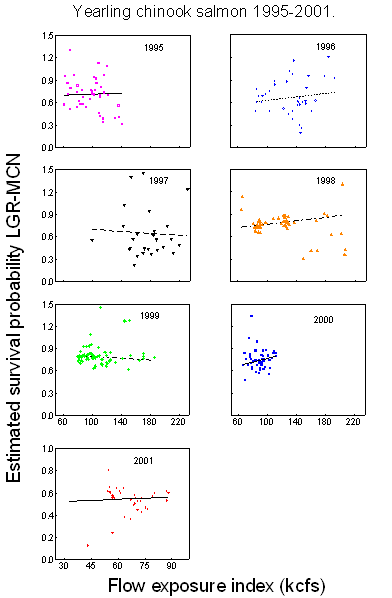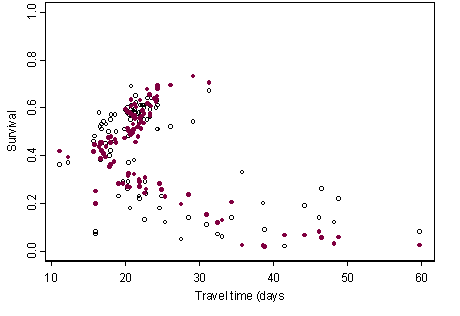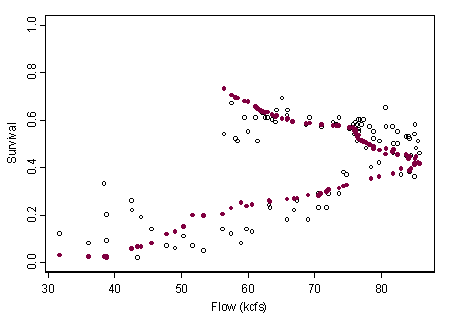
That the Earth is not the centre of the universe nor immoveable, but that it moves, even with a diurnal motion, is . . . a proposition absurd and false in philosophy, and considered in theology ad minus erroneous in faith . . .
Sentence of the Tribunal of the Supreme Inquisition against Galileo Galilei (June 22, 1633)
Slowly but surely, as Federal government funding of science expands, and the cadres of the politically-correct metastasize through academia, the scientific establishment has taken on the characteristics of a faith-based organization. The Columbia and Snake River Dams, spinning off a river of government science funding, have produced legions professing One True Faith: that the dams kill salmon and must be made to pay. And, in particular, reservoirs should not store water to generate electricity at the dams, but should instead store water to increase flows "for fish". Tony Grover, formerly the Director of the Eastern Regional Office of the Washington Department of Ecology, has summarized the situation succinctly: "The arguably most sacred of the Columbia-Snake sacred cows is the ten-year-old-plus article of faith that flow augmentation is good for fish. Period. End of discussion."
There never was a coherent theoretical basis for imagining that increasing river flows would benefit salmon. Higher flows make it more difficult for adult salmon to swim upstream. Adherents of the Faith speculate that higher river flows may move juvenile salmon downstream faster, but that offers no advantage to juvenile salmon unless there are benefits from being down the river faster. No one has ever documented any such benefits, though it is true that salmon initially evolved in a world without dams where they reached the bottom of the river faster.
The lack of documentation is not for lack of effort. For many years now, government biologists have been plotting juvenile salmon survival against flow, and failing entirely to demonstrate any significant relationship between flow and survival. Here, for example, are several years of data from a National Marine Fisheries Service PowerPoint presentation in December 2002:

This and other "flow/survival" work posits a simple linear relationship, such that by increasing river flows, one can increase salmon survival. Hundreds of studies have attempted to demonstrate a statistically significant flow/survival relation, but few have succeeded. Of course, just as monkeys at typewriters can occasionally produce prose, so too can the adherents of the One True Faith occasionally demonstrate correlations in otherwise random data. Nevertheless, it is widely believed that cutting electric power production to increase river flows will produce salmon, just is it was generally accepted in the times of Galileo that the sun revolved around the earth.
We live in kindler and gentler times than the Inquisition. Nowadays, instead of the "Tribunal of the Supreme Inquisition", we have committees of government scientists. Instead of house arrest, they punish heresy by ignoring the offenders or cutting off their funding. Instead of Galileo Galilei, we have Professor James Anderson of the University of Washington.
Like Galileo's insight, Professor Anderson's is ultimately simple: baby salmon don't die in the Columbia River just from spending time there; they die primarily because predators eat them. How many salmon the predators eat depends largely upon three things: the frequency of encounters with predators as the baby salmon swim downstream (primarily a function of distance traveled), whether the predators can see them (primarily a function of the turbidity of the water), and how hungry the predators are (metabolism, largely a function of temperature).
Dr. Anderson's theory, documented in his two recent papers "An analysis of smolt survival with implications to flow management" and "A collision theory based predator-prey model and application to juvenile salmonids in the Snake River Basin", states, in its simplest form, that
![]()
Here, S is the survival through any particular reach of the Columbia and Snake Rivers, Sdam is the survival through the dam in that river reach, beta is a constant, theta is temperature, m is a parameter to shape the influence of temperature on predation, phi is water turbidity, n is a parameter to shape the influence of turbidity on predation, and x is the smolt migration distance. Dr. Anderson does not include flow as a variable to explain salmon survival at all, rejecting flow's centrality to salmon survival just as boldly as Galileo rejected the notion that the sun revolved around the earth.
The striking thing about Dr. Anderson's theory is the way that it can make non-linear predictions about salmon survival that fit the actual data amazingly well. In short, the theory is based on reality, not faith. Real world data does not show salmon survival rising in a simple straight line with increased flows and decreased travel time, and only Dr. Anderson's model actually fits the data. For example, here is predicted and observed chinook survival vs. travel time for migration between Lower Granite Dam and McNary Dam in 2001. (Survival estimated from tags on the salmon is designated (○); survival estimated with the Dr. Anderson's model is designated (●).)

And here is predicted and observed survival over the same river reach and time interval as a function of flow:

How has the Green Church responded to Dr. Anderson's work? By ignoring it. On February 11, 2003, the Independent Science Advisory Committee (ISAB) of the Northwest Power Planning Council released a lengthy "Review of Flow Augmentation: Update and Clarification" (1.6 Mb Acrobat file). The ISAB was formed after Congress eventually realized that the Northwest Power Planning Council was getting bad advice from the Region's fish managers, who have constructed a huge, well-funded salmon recovery empire upon their unchallenged assertions as to what was needed for fish. Fish "needs" in the form of increased river flows and spill over dams now constitutes a tax on Pacific Northwest electric ratepayers that reached over $1.5 billion in 2001.
As workers across the Northwest are losing their jobs because of rising electric rates assessed to pay these costs, the Northwest Power Planning Council finally worked up the courage reassess the strategy of increasing flows. The Council formally asked the ISAB a number of questions, including "to what extent will changes in reservoir release strategies that could result in decreases in spring and summer flows of approximately 10% or less have a statistically significant effect on juvenile salmon and steelhead survival"?
The ISAB, apparently entirely composed of Church members, didn't really answer the question. Indeed, the ISAB has admonished the Council that "the wording of the question in terms of 'statistical significance' of the effect is inappropriate". A rejection of statistical significance exemplifies the adoption of a faith-based approach to public policy, as opposed to a scientific one. The ISAB declared, in substance, that it does not matter that 10% changes in flow do not cause any measurable change in salmon survival because "small effects could still matter". In a world of limitedless resources, spending transfinite amounts of money for effects too small even to detect might make sense. In the real world, where we put crazy people out on the street for lack of public funds, this attitude is grossly irresponsible and morally reprehensible.
Following the lead of other Church members at the National Marine Fisheries Service, the ISAB replaces scientific statistical analysis with "I can draw a line" analysis. Thus the ISAB adopts what it calls the "broken stick" model of salmon survival as a function of flow:

Review of the annual charts reproduced above demonstrates that the lower measured survival at low flows shows up as a single data point from 2001, and it is obvious that there is no correlation whatsoever between changes in flow and survival in most years with Snake River flows as low as 60,000 cubic feet/second (cfs). As for the one data point below 50,000 cfs, in 2001, it represents less than 1% of the fish migrating downstream during 2001, who probably suffered low survival from high temperatures, not low flows. In short, there is not even a statistically detectable correlation between river flow and salmon survival in the Columbia and Snake Rivers, much less a causal relationship. (While this diagram purports to represent the sum of the seven individual year charts above, it mysteriously contains additional data points at the low end of the flow scale.)
Nevertheless, the ISAB insists that "below approximately 100,000 cfs, steady levels of flow may be needed to avoid deleterious effects". Of course, they may not be needed, either. Society calls upon experts to provide advice as to real world significance, but the Council has evidently called upon High Priests to bolster faith against a reality that negates the One True Faith.
Insofar as one of the principal objectives of the flow increase program is to protect allegedly endangered species, the Council also had the perspicacity to ask whether reducing flows "pose a risk to the survival of fish populations . . . [and i]f so, what are the risks and how significant are they?" The ISAB, however, flatly refuses to answer that question as well. Instead, the ISAB proclaims that "decisions to implement actions that have any potential for adversely affecting an ESU that is listed under the ESA will be required to satisfy a burden of proof that no harm is likely to be done as a result of that action".
As Church members, the ISAB members are flatly unwilling to opine that reducing flows by 10% in the mighty Columbia River is unlikely to harm fish, for that is, to them, "a proposition absurd and false in philosophy, and considered in theology ad minus erroneous in faith . . ." Indeed, for the Green Church, it is ad minus erroneous in faith even to raise the question whether a species is actually endangered, for another central tenet of the One True Faith is that the earth is about to become a lifeless hulk from human exploitation of natural resources. Slowly but surely, the growth of the Faith is imposing an insurmountable burden of proof to prove the absence of any harm on anyone who does anything that might affect Nature.
Contrary views are, for the most part, simply ignored. Nowhere in its 69-page review does the ISAB even refer to Dr. Anderson's model, though its members were well aware of it. It now appears that a majority of the Northwest Power Planning Council consists of Church members too, or is at least afraid to speak against the Church. A competent Council would fire the ISAB for refusing to answer its questions and abandonment of the scientific method.
The last person to speak against the One True Faith, Oregon Council member John Brogiotti, was summarily fired by Governor Kitzhaber. His parting shot:
"With our nation at war, even a dumb farmer knows that it's one hell of a time to destroy our agriculture and industry. I'll tell you one thing; when it comes to deciding which is more important, a fish or a child, the guys who flew the planes into the World Trade Center aren't going to have trouble deciding."
While those "guys" are of a different Church, in the long run, they're probably not going to cause as much damage to our country as the Green Church is.
© James Buchal, February 19, 2003
You have permission to reprint this article, and are encouraged to do so. The sooner people figure out what's going on, the quicker we'll have more fish in the rivers.
![]()
Return to Other Salmon Materials
Return to www.buchal.com